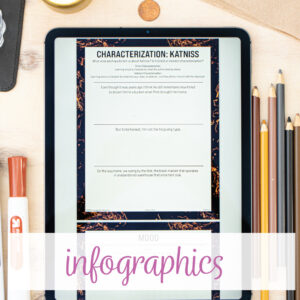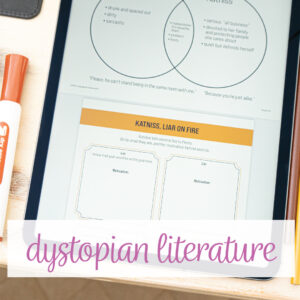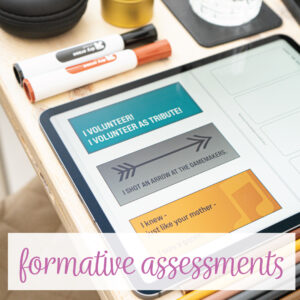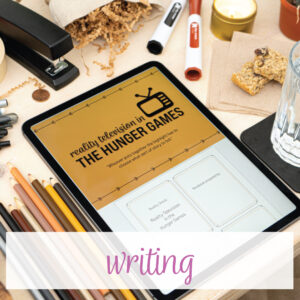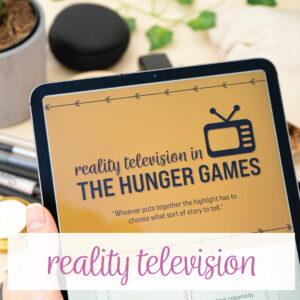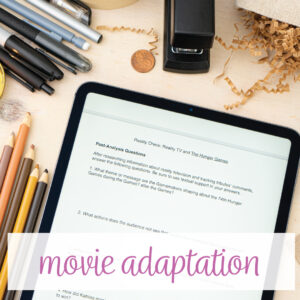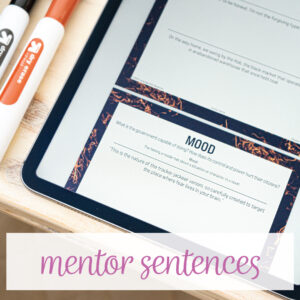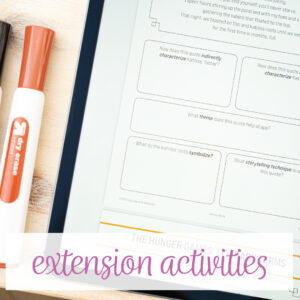Are you looking for The Hunger Games lesson plan ideas? I have taught the famous novel as well as Catching Fire and Mockingjay—all multiple times.
Each chapter ends with a cliffhanger, a love story spans three books, and a memorable heroine takes charge: I love teaching The Hunger Games. Any time that students become excited about literature, I love a story even more than I previously did. Young readers really enjoy this series, and I have taught it in both middle school and high school. My Hunger Games lesson plans have evolved, and I’ve created Hunger Games activities for middle and high school students.
This dystopian fiction is rich in imagery, symbolism, and vocabulary. Since students enjoy the trilogy, building a variety of learning tools was a natural step.
What are some creative lesson plan ideas based on “The Hunger Games”?
Some creative lesson plan ideas based on The Hunger Games include analyzing the themes of power and oppression, creating a dystopian project, and organizing a discussion on ethical dilemmas in the book.
No matter your format (lit circles, whole class novel) you can implement these pieces into your lessons. The Hunger Games lesson plan ideas: Use the following ideas to form or build your dystopian study.
The author: Suzanne Collins
Any Hunger Games pre-reading activities I use with students involves looking at the author. They can easily find information about the creator.
Show an interview of Suzanne Collins talking about the background of The Hunger Games. Before I watched that video, I was unaware that the story had mythological origins. That’s perfect prior knowledge to build off for readers who love the Percy Jackson series. Classes love talking about books they enjoy!
Collins also discusses her inspiration for starting the story which students might find intriguing. Hooking them before diving into the rest of your The Hunger Games lesson plan ideas will pay off later.
Finally, students might note that the author does not keep a heavy social media presence. Still, her books sell incredibly well, and she has a loyal following. Ask them to weigh in on authors and visibility.
Infographics
After teaching The Hunger Games a few times, I realized the depth of material included in the book. (Overall, we could analyze the texts in many ways, but some students found some of the material overwhelming.) Students might find some of the story confusing and need support. I often make anchor charts a staple in my Hunger Games activities.
If students find the characters confusing, clarify the characters with infographics. Classes can add descriptions, quotes, and actions from the characters to personalize the meaning. Plus, you can use the final images as review when you finish the book. Those who continue with the book series will also appreciate this character review, as names are referenced throughout all the books.
Dystopian literature: Anticipation
The Hunger Games lesson plans should include a background of the genre. Students might not be familiar with dystopian literature. Explain the background and genre so their knowledge expands. If students enjoy dystopian literature, you can explore speculative fiction with them too.
A simple anticipation activity is to explain the genre. When readers understand what to expect from the genre, the story will take less time to figure out.
After students finish the series, you can suggest other dystopian books. I enjoyed Divergent, The Fifth Wave, and The Grace Year. If you learn that they enjoy that genre, you can add dystopian novels to your First Chapter Friday list. Whenever I teach any dystopian literature, I pull out all of my dystopian classroom library books for display. That way, our discussions can broaden, and hopefully, young readers pick up more books.
The setting quizzes: Panem and The Capitol
My biggest suggestion for The Hunger Games lesson plan ideas? Include comprehension checks. Formative assessments provide quick feedback and allow you to end confusion with readers.
Nothing is more frustrating to me as an ELA teacher than to watch readers read and come back frustrated and confused. When I give comprehension questions, I can quickly identify any areas of confusion and address them before they escalate.
I rarely give points over comprehension. Instead, we discuss confusing points, outline events from different settings, and clarify characters. Quick multiple choice questions allow me to provide fast feedback in a non-embarrassing manner.
Writing
Students remember concepts when they write about those ideas. Include time for writing in your The Hunger Games lesson plans. For higher order thinking questions, I provide choice with an assortment of prompts. Not every student will feel inspired by every prompt!
I share and utilize journaling prompts with students many ways:
- Quick exit tickets.
- Group writing (where students each contribute ideas to a journal).
- Brainstorming for larger writing assignments.
Another idea is to have students write journal entries from the perspective of a resident in Panem or The Capitol. This activity encourages students to consider how different characters might experience life in this dystopian society.
Sometimes, I don’t incorporate journaling prompts into my lesson plans. Instead, once we have a fabulous discussion, I’ll add on one of the prompts to cement students’ understanding of our conversation. As always, a variety of writing prompts allows for student choice.
Reality television and propaganda
Discuss the implications of audiences not understanding the setup and performance of reality television. Katniss is incredibly aware (as are the other tributes) that their performance during the show earns food, safety, and money. The final viewing with Caesar, a montage of clips, is heavily edited to portray what the Capitol wants citizens to see.
I typed out every example of reality television from the book. After providing informational texts about reality television, students and I examine the effect that propaganda had on the citizens of Panem. Students understand that television and advertising manipulates them, and you can explore data and statistics concerning medial while teaching The Hunger Games.
And, yes—you will be able to discuss the scripting of framing of reality television that students watch after students see the manipulation the Capitol had on its citizens.
Movie: Symbolism
The movie is well done, and you can meet standards if you show the movie to students and ask them to compare the book and movie. Some parts were added to the movie, and some were taken away. What was the effect? Were the changes improvements? Students love critiquing movies, and you can incorporate lessons on text support and citations in a written response.
For instance, President Snow drinks champagne, and the glass turns pink from his blood. That portion is not in the books. What is the changing color symbolic of? Is this addition adding suspense or a character piece?
Other options include a basic movie review, a T-chart, or a one pager to cap off the movie and your Hunger Games novel study.
Mentor sentences
Since students enjoy the story, you can easily meet language standards with the material. This free download includes sentences for everyone to analyze and includes an answer key for you. Mentor sentences allow for meeting both language and literature standards.
If you are just getting started with mentor sentences, here are some questions to pose with learners:
- What do you notice about the sentence? Note if it is long or short. Can you find the subject? Tell me about the verb.
- Deconstruct it: Break down this sentence using complex analysis. Did the author use active or passive voice, for instance? Why?
- What is the message?
- Tie the meaning to the language: How did the author convey her message?
Plus, dystopian literature often contains ample use of the subjunctive mood. If you need to cover verb moods, you will be able to pull samples from this novel.
Once you begin discussing sentences with students, they will analyze literature in a new way.
Webquest, worksheets, crossword puzzles
When I taught sixth grade, classes did explore concepts like dystopias, propaganda, and other concepts with a quick webquest or worksheet. However, with older students, The Hunger Games lesson plan ideas took on less structure.
Readers honestly invested in the material, and worksheets took away from their investment. Plus, we spent time diving into the language with mentor sentences and crossword puzzles took time from rich discussions. Four my unit, I did not rely on such tools with older readers.
Extension activities
A common extension activity with The Hunger Games is creating an art piece. My students have created collages, movie posters, and skits to end our unit. Once, students and I mapped out what would happen in the next book—a sort of prediction activity.
Another activity that readers enjoy is to have students create a map of Panem and The Capitol. This visual representation helps them understand the geography and layout of the world in which the story takes place. They can label key locations, such as District 12 or the Cornucopia, and include important details about each district.
Sometimes, I simply ask classes what they want to create. Their ideas are often quite suitable! Incorporate Canva and other user-friendly resources into your The Hunger Games lesson plan ideas.
Final question: How do the Hunger Games reflect society?
The Hunger Games reflects society by exploring themes of power, inequality, and the effects of media manipulation. The dystopian world created in the story serves as a cautionary tale about the dangers of unchecked authority and the importance of individual agency in the face of injustice.
When students can answer that question, you’ll know that your unit and activities have made an impression.
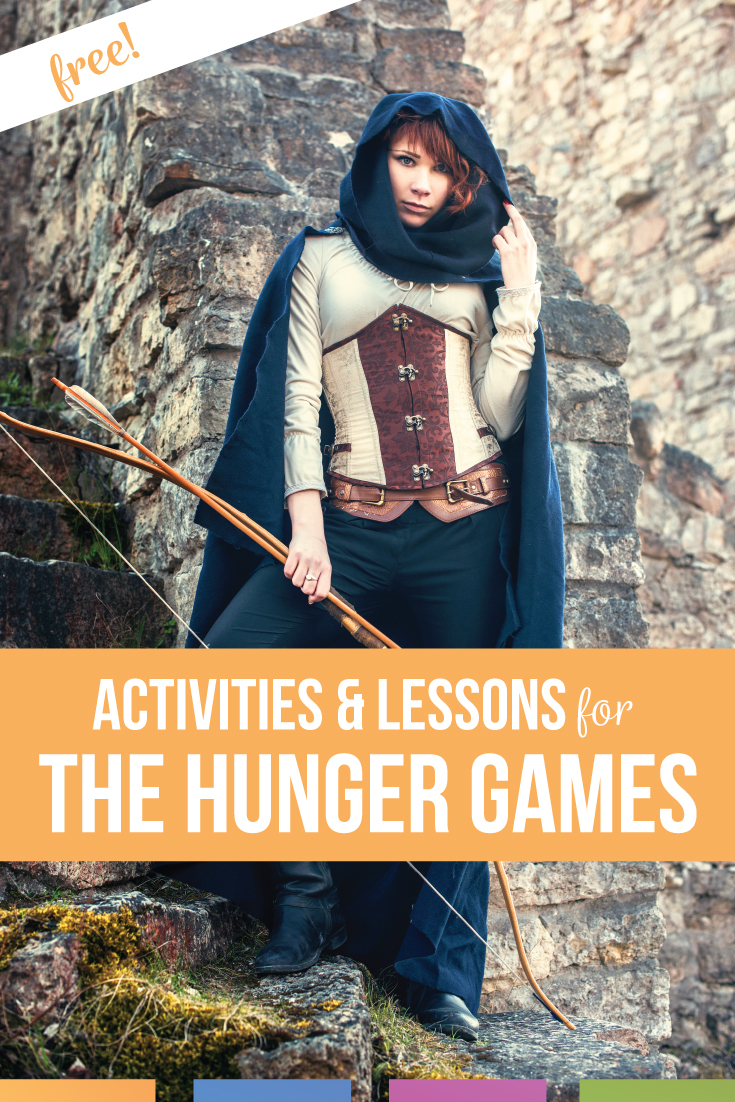
The Hunger Games Lesson Plan
Honestly, teaching The Hunger Games and the subsequent stories remains a highlight of my teaching career. The books allowed for a diversity of conversations and activities. Since the stories reflected pieces of real life, I could bring in news stories and connect the story to students’ lives. I hope you have a similar experience.
You probably already have started to gather The Hunger Games lesson plan ideas. I hope these videos, informational texts, and resources enhance your novel unit. If you need a complete Hunger Games novel study, check out my Hunger Games Unit.



